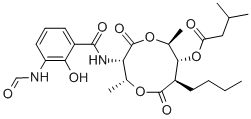Chemical Properties
Antimycin (A3C26H36N2O9) and (Antimycin
A1) C28H40N2O9 are crystalline solids.
Uses
Antimycin A3 is a homologue of the antimycin complex, first isolated in 1958 from Streptomyces blastimyceticus and co-produced with antimycin A4. Antimycin A3 is a more polar analogue of A1 and A2. Like all antimycins, antimycin A3 is a potent inhibitor of respiration by inhibiting the oxidation of ubiquinol to ubiquinone. Antimycin A3 exhibits broad biological activity as an antifungal, anthelmintic, insecticidal, antiviral and antitumor active. Lack of availability of the individual antimycin components has hindered greater understanding of the common and unique molecular targets of the components of the antimycin complex.
Potential Exposure
Specific uses for antimycin A were
not found, however, antimycin A1, and antimycin A3 are
reported to be antibiotic substances produced by streptomyces
for use as a fungicide, possible insecticide and miticide.
Registered as a pesticide in the U.S.
First aid
Move victim to fresh air. Call 911 or emergency
medical service. Give artificial respiration if victim is not
breathing. Do not use mouth-to-mouth method if victim
ingested or inhaled the substance; give artificial respiration
with the aid of a pocket mask equipped with a one-way
valve or other proper respiratory medical device.
Administer oxygen if breathing is difficult. Remove and
isolate contaminated clothing and shoes. In case of contact
with substance, immediately flush skin or eyes with running
water for at least 20 minutes. For minor skin contact,
avoid spreading material on unaffected skin. Keep victim
warm and quiet. Effects of exposure (inhalation, ingestion
or skin contact) to substance may be delayed. Ensure that
medical personnel are aware of the material(s) involved
and take precautions to protect themselves. Medical observation
is recommended for 24 to 48 hours after breathing
overexposure, as pulmonary edema may be delayed. As
first aid for pulmonary edema, a doctor or authorized paramedic
may consider administering a drug or other inhalation
therapy.
Shipping
UN2811 Toxic solids, organic, n.o.s., Hazard
Class: 6.1; Labels: 6.1-Poisonous materials, Technical
Name Required.
Definition
ChEBI: Purothionin AII is an amidobenzoic acid.
